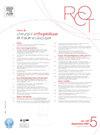Quelles métatarsalgies opérer ?
Q4 Medicine
Revue de Chirurgie Orthopedique et Traumatologique
Pub Date : 2025-02-15
DOI:10.1016/j.rcot.2025.01.016
引用次数: 0
Abstract
Le traitement chirurgical des métatarsalgies reste controversé, et repose sur la compréhension des causes biomécaniques et anatomiques. La cause fondamentale des métatarsalgies est la répétition des forces et des pressions plantaires localisées sur l’avant-pied pendant le cycle de la marche. Il est fondamental de différencier les métatarsalgies statiques (liées aux pentes métatarsiennes et à la rétraction du système suro-achilléo-plantaire), des métatarsalgies propulsives, les plus fréquentes (liés aux anomalies de longueurs). Trois catégories étiologiques sont retrouvées : primaires (d’origine anatomique), secondaires (causes variables de surcharge de l’avant-pied) et iatrogènes post-chirurgicales. Examiner l’avant-pied, mais également l’arrière-pied, rechercher la rétraction des gastrocnémiens et analyser radiologiquement, en charge, les déformations dans les plans horizontal (courbe et morphotypes de Maestro) et sagittal, seront décisifs pour le diagnostic, aidé selon les situations, par l’échographie et/ou l’IRM, mais aussi le Conebeam en charge. Le traitement sera d’abord conservateur (modifications du chaussage, orthèse plantaire, étirements), avec un taux de succès important. En marge des ostéotomies métatarsiennes, le traitement chirurgical participera à restaurer une distribution normale de la pression sur l’avant-pied : allongement des jumeaux, transfert tendineux, réparation de la plaque plantaire. Si certaines techniques doivent être abandonnées, les ostéotomies métatarsiennes, indiquées uniquement pour corriger les anomalies des métatarsiens, peuvent être classées selon leur site anatomique (proximale basale – diaphysaire – distale) ou leur but biomécanique (élévatrice et/ou raccourcissante). L’approche percutanée, mini-invasive est en plein essor. Les prothèses en silicone permettent de faire face à des situations complexes. Trois situations peuvent être distinguées pour proposer un algorithme thérapeutique : les métatarsalgies avec ou sans pathologie du 1er rayon et les métatarsalgies associées aux pathologies inflammatoires. La stabilisation du 1er rayon est fondamentale. Les métatarsalgies « propulsives » nécessiteront un raccourcissement métatarsien, certaines métatarsalgies « statiques », plutôt une élévation. Celles liées à des pathologies de l’arrière-pied seront généralement traitées de façon conservatrice ou selon l’étiologie. Le traitement des métatarsalgies sera médico-chirurgical adapté aux données biomécaniques, cliniques et paracliniques, préalablement évaluées. Quatre-vingt-dix pour cent des métatarsalgies ont une origine biomécanique.
Niveau de preuve
V ; avis d’expert.
Surgical treatment of metatarsalgia remains controversial. It depends on an understanding of the biomechanical and anatomical causes. The fundamental cause of metatarsalgia is the repetition of plantar forces and pressures localized on the forefoot during the gait cycle. It is essential to differentiate between static metatarsalgia (linked to metatarsal slopes and retraction of the suro-achilleo-plantar system), and the more frequent propulsive metatarsalgia (linked to length anomalies). Three etiological categories have been identified: primary (anatomical in origin), secondary (variable causes of forefoot overload) and iatrogenic post-surgical. Examination of the forefoot, but also the hindfoot, looking for retraction of the gastrocnemius and radiological analysis, under load, of deformations in the horizontal (Maestro curve and morphotypes) and sagittal planes are decisive for diagnosis, aided as appropriate by ultrasound and/or MRI, but also the Conebeam under load. Initially, treatment will be conservative (changes in footwear, foot orthosis, stretching), with a high success rate. In addition to metatarsal osteotomies, soft-tissue surgery can help restore normal pressure distribution on the forefoot: gastrocnemius lengthening, tendon transfer, repair of the plantar plate. If certain techniques have to be abandoned, metatarsal osteotomies, indicated solely to correct metatarsal anomalies, can be classified according to their anatomical site (proximal basal – diaphyseal – distal) or biomechanical purpose (elevating and/or shortening). The percutaneous, minimally invasive approach is in full expansion. Silicone prostheses make it possible to deal with complex situations. Three situations can be distinguished when proposing a treatment algorithm: metatarsalgia with or without 1st ray pathology, and metatarsalgia associated with inflammatory pathologies. Stabilization of the 1st radius is fundamental. “Propulsive” metatarsalgia requires metatarsal shortening, while some “static” metatarsalgia requires elevation. Metatarsalgia related to hindfoot pathologies is generally treated conservatively or according to etiology. Treatment of metatarsalgia should be medico-surgical, adapted to the biomechanical, clinical and paraclinical data previously assessed. Ninety percent of metatarsalgia has a biomechanical origin.
Level of evidence
V; expert opinion.
要做哪些手术?
证据水平v;专家的意见。
本文章由计算机程序翻译,如有差异,请以英文原文为准。
求助全文
约1分钟内获得全文
求助全文
来源期刊

Revue de Chirurgie Orthopedique et Traumatologique
Medicine-Surgery
CiteScore
0.10
自引率
0.00%
发文量
301
期刊介绍:
A 118 ans, la Revue de Chirurgie orthopédique franchit, en 2009, une étape décisive dans son développement afin de renforcer la diffusion et la notoriété des publications francophones auprès des praticiens et chercheurs non-francophones. Les auteurs ayant leurs racines dans la francophonie trouveront ainsi une chance supplémentaire de voir reconnus les qualités et le intérêt de leurs recherches par le plus grand nombre.
 求助内容:
求助内容: 应助结果提醒方式:
应助结果提醒方式:


